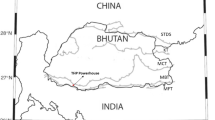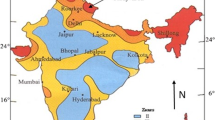Abstract
Long term stability of an underground cavern is significant for construction engineers. For structures constructed in the geologically active regions of the Himalayas, continuous monitoring is required to ward off the sustained threats due to seismic activities and associated local geological hazards. Underground powerhouse of Tapovan Vishnugad Hydropower Power Project (TVHPP), Chamoli, Uttarakhand is one such powerhouse that encountered various types of rockmass failures both during and post construction. The project area is located about 2.0 km north of the Main Central Thrust (MCT) and the rockmass cavern has numerous joints, shear and seam zones and fractures. This pose threat to the long term stability of this underground powerhouse cavern. To analyse the rockmass stability of the powerhouse, real time microseismic monitoring system was installed in this underground cavern. Spatio-temporal variation of the recorded seismic events has been analysed for microseismic events distribution in terms of seismic energy, displacement, cumulative apparent volume and various other contours led to the identification of potentially hazardous zones in the underground rockmass structure.
Similar content being viewed by others
References
Aswegen G. Van, Mendecki, A.J., Lachenicht, R., Dzhafarov, A. H., Hofmann, Radu, G.S., Eneva, M., Sciocatti, M. and Kotze, G. (1999) Mine layout, geological features and seismic hazard, GAP-303, ISS International Limited, http://researchspace.csir.co.za/dspace/bitstream/handle/10204/1697/gap303.pdf;jsessionid=5E3E7DAD5E53D25B88C45BCCAB5EA669?sequence=1.
Aswegen G. Van and Butler, A.G. (1993) Applications of quantitative seismology in South African gold mines. Proc. 3rd Internat. Symp. Rockbursts and Seismicity in Mines. Rotterdam: AA Balkema, pp.261–266.
Blenkinsop, T. G. (2008) Relationships between faults, extension fractures and veins, and stress. Jour. Struct. Geol., v.30/5, pp.622–632. DOI: https://doi.org/10.1016/j.jsg.2008.01.008
Bormann, P., Baumbach, M., Bock, G., Grosser, H., Choy, G. L., & Boatwright, J. (2009) Seismic sources and source parameters. Geo Forschungs Zentrum (Ed.) New manual seismological observatory practice, vol 1, pp. 1–94. Potsdam.
Butler, G.V.A. and Van, A.G. (1993) Applications of quantitative seismology in South African gold mines’. Proc.e 3rd Internat. Symp. on Rock bursts and Seismicity in Mines. Rotterdam: AA Balkema, pp.261–266.
Caving, S. and Potvin, Y. (2008) Seismic monitoring of the Northparkes lift 2 block cave — Part 1 Undercutting. South African Institute of Mining and Metallurgy, July, pp335–354.
Chen, F., Ma, T., Tang, C., Du, Y., Li, Z. and Liu, F. (2018) ‘Research on the Law of Large-Scale Deformation and Failure of Soft Rock Based on Microseismic Monitoring. Advan. Civil Engg., v.8. DOI: https://doi.org/10.1155/2018/9286758
Dai, F., Li, B., Xu, N., Zhu, Y. and Xiao, P. (2015) Stability evaluation on surrounding rocks of underground powerhouse based on microseismic monitoring. Shock and Vibration, v.9. DOI: https://doi.org/10.1155/2015/937181
Dunnicliff, J. (1982) Geotechnical Instrumentation for monitoring field performance. Washington.
Emsley, S., Olsson, O., Stenberg, L., Alheid, H. and Falls, S. (1997) ZEDEX-A study of damage and disturbance from tunnel excavation by blasting and tunnel boring. Retrieved from <http://inis.iaea.org/search/search.aspx?orig_q=RN:29050588>
Enrique, Rubio and Daulat, N. (2007) Caving performance through the integration of microseismic activity and numerical modeling at DOZ-PT freeport, Indonesia. Erik Eberhardt, Doug Stead T.M. (Eds.) First Canada-U.S. Rock Mechanics Symposium. Taylor & Francis.
Esso Highlands Limited (2006) Environmental Assessment Report, Papua New Guinea: PNG Gas Project, Vol. 26.
Essrich, F. (2005) Mine Seismology for Rock Engineers-An Outline of Required Competencies. Proc. Sixth Internat. Symp. on Rockbursts and Seismicity in Mines, pp.359–364.
Finno, R.J. (1991) Geotechnical instrumentation for monitoring field performance. Engg. Geol., v.30/2, pp.237–238. Elsevier BV. DOI: https://doi.org/10.1016/0013-7952(91)90045-m
Glazer, S.N. (2018) Mine seismology: Seismic response to the caving process: A case study from four mines. Mine Seismology: Seismic Response to the Caving Process: A Case Study from Four Mines. Springer International Publishing. DOI: https://doi.org/10.1007/978-3-319-95573-5
Gutenberg, B. and Richter, C.F. (1956) Magnitude and energy of earthquakes. Annali di Geofisica, v.9/1, pp.7–12. DOI: https://doi.org/10.4401/ag-4588
Hudyma, M.R. (2008) Analysis and interpretation of clusters of seismic events in mines. University of Western Australia.
Laubach, S.E., Lamarche, J., Gauthier, B.D. M., Dunne, W.M. and Sanderson, D. J. (2018) Spatial arrangement of faults and opening-mode fractures. Jour. Struct. Geol., v.108, pp.2–15. Elsevier Ltd. DOI: https://doi.org/10.1016/j.jsg.2017.08.008
Li, B., Xu, N., Dai, F., Zhang, G. and Xiao, P. (2019).Dynamic analysis of rock mass deformation in large underground caverns considering microseismic data. Internat. Jour. Rock Mechanics and Mining Sciences, 122/August: 13. Elsevier Ltd. DOI: https://doi.org/10.1016/j.ijrmms.2019.104078
Madariaga, R. (1989) Seismic source: Theory. Geophysics, pp. 1129–33. Springer US: Boston, MA. DOI: https://doi.org/10.1007/0-387-30752-4_137
Martin, C.D., Kaiser, P.K. and Christiansson, R. (2003) Stress, instability and design of underground excavations’, Internat. Jour. Rock Mechanics and Mining Sciences, v.40/7–8, pp.1027–47. DOI: https://doi.org/10.1016/S1365-1609(03)00110-2
McGarr, A. and Fletcher, J.B. (2003) Maximum slip in earthquake fault zones, apparent stress, and stick-slip friction. Bull. Seismolog. Soc. Amer., v.93/6, pp.2355–2362. DOI: https://doi.org/10.1785/0120030037
Mcgarr, A. (1991) Observations Constraining Near-Source Ground Motion Estimated From Locally Recorded Seismograms. Jour. Geophys. Res., v.96/16, pp.495–508.
Mendecki, A.J. (2012) Size Distribution of Seismic Events in Mines. Australian Earthquake Engg. Soc., p. 20. Queensland.
Mendecki, A.J. (2015) Mine Seismology Reference Book Seismic Hazard. Institute of Mine Seismology.
Mendecki A.J., Lynch, R.A. and Malovichko, D.A. (2010) Routine Micro-Seismic Monitoring in Mines. Australian Earthquake Engg. Soc., pp. 1–33. Perth.
Moore, D.E. and Lockner, D.A. (1995) The role of microcracking in shear-fracture propgation in granite. Jour. Struct. Geol., v.17/1, pp.95–114. DOI: https://doi.org/10.1016/0191-8141(94)E0018-T
Naithani, A.K. and Murthy, K.S.K. (2006) Geological and geotechnical investigations of Tapovan — Vishnugad Hydroelectric Project, Chamoli District, Uttarakhand, India. Jour. Nepal Geol. Soc., January 2006.
Sujit Dasgupta, Prabhash Pande, Dhruba Ganguly, Zafae Iqbal, Kanika Sanyal, N.V. Venkataraman, Sabyasachi Dasgupta, Basudev Sural, L. Harendranath, K. Mazumdar, Satrajit Sanyal, A. Roy, L. K. Das, P. S. M. and H. K. G. (2000) Seismotectonic Atlas of India and its Environs.
van Aswegen, G., Mendecki, A.J., Lachenicht, R., Dzhafarov, A.H., Hofmann, G., Radu, S., Eneva, M., Sciocatti, M. and Kotze, G. (1999) Mine layout, geological features and seismic hazard.
Vikalp Kumar, N. Gopalakrishnan, N.P.S. and S.C. (2019) ‘Microseismic monitoring application for primary stability evaluation of the powerhouse of the Tapovan Vishnugad Hydropower Project. Jour. Earth System Sci., v.128/6. DOI: https://doi.org/10.1007/s12040-019-1191-9
Virgo, S., Abe, S. and Urai, J.L. (2014) The evolution of crack seal vein and fracture networks in an evolving stress field: Insights from Discrete Element Models of fracture sealing. Jour. Geophys. Res.: Solid Earth, v.119/12, pp.8708–8727. DOI: https://doi.org/10.1002/2014JB011520
Vyshnavi, S., Islam, R. and Sundriyal, Y. P. (2015) Comparative study of soil profiles developed on metavolcanic (basaltic) rocks in two different watersheds of Garhwal Himalaya. Curr. Sci., v. 108/4, pp.699–707. DOI: https://doi.org/10.18520/cs/v108/i4/699-707
Xiao, P., Li, T., Xu, N., Zhou, Z. and Liu, X. (2019) Microseismic monitoring and deformation early warning of the underground caverns of Lianghekou hydropower station, Southwest China. Arabian Jour. Geosci., v. 12/16, pp.18. DOI: https://doi.org/10.1007/s12517-019-4683-7
Xiao, P., Qian, B., Jiang, P., Xu, N. and Li, B. (2018) Deformation Forecasting of Surrounding Rock Mass Based on Correlation between Frequency and Fracture Scale of Microseismicity. Advan. Civil Engg., 2018. DOI: https://doi.org/10.1155/2018/4037402
Acknowledgement
This study is based on the Microseismic monitoring study conducted at TVHPP. The authors are grateful to the Director, National Institute of Rock Mechanics for the necessary support and approval to publish these findings. The authors are also grateful to the Management (for sponsoring, logistic and access for this study) and staff at TVHPP NTPC Ltd. Special thanks are due to Mr. N. Gopalakrishnan, DGM, NTPC Ltd. for providing the requisite site literature and other logistic support at site during the monitoring period. Help from colleagues of NIRM is also acknowledged. An honest thanks to Dr. Iram Saba Amin for proof-reading.
Author information
Authors and Affiliations
Corresponding author
Rights and permissions
About this article
Cite this article
Kumar, V., Jha, P.C., Singh, N.P. et al. Application of Microseismic Monitoring in Analysing the Stability of Underground Cavern. J Geol Soc India 97, 1379–1386 (2021). https://doi.org/10.1007/s12594-021-1876-y
Received:
Accepted:
Published:
Issue Date:
DOI: https://doi.org/10.1007/s12594-021-1876-y




